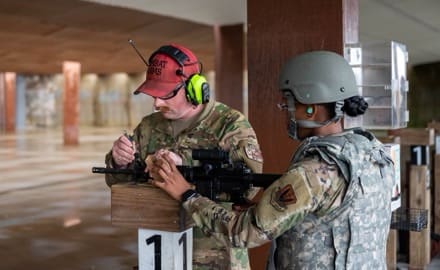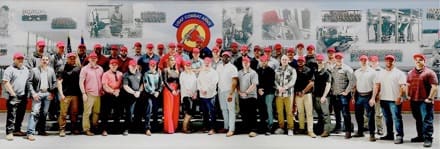
JOINT BASE SAN ANTONIO-LACKLAND, Texa —
Air Force Security Forces is looking to strengthen the combat arms training and maintenance community while also delivering better training opportunities for Airmen and Guardians.
The Combat Arms Working Group, a joint effort between the Air Force Security Forces Center, Headquarters Air Force Security Forces and major command representatives, is focused on evolving CATM for the first time since a Security Forces merger in 1997, said Chief Master Sgt. Donald Gallagher, SF career field manager.
At that time, law enforcement and security specialists were combined and the military working dog and combat arms disciplines were not individual specialties. With those things in mind, more than 50 CATM professionals met recently in San Antonio to establish a concept of action for the manpower agency to use to create the first ever CATM Air Force job qualification standard.

“The current standard is the most complicated formula in the Air Force and uses outdated methods and statistics to establish CATM manpower,” said Jason Seibel, Air Force Combat Arms Program chief at AFSFC.
“It is imperative we have a full team of CATM professionals at every installation across the enterprise to provide first-class weapons training to our warfighting Airmen and Guardians,” he said. “With Air Force Force Generation, Ready Airman Training and Multi-Capable Airmen, the demand is only going to increase, and we need to get this right, right now.”
The Air Force Job Qualification Standard is key to the success of the career field. Together with the career field education and training plan approved earlier this year, CATM instructors will now have a training roadmap from the moment they enter the career field as junior Airmen until they’re master sergeants, Seibel said.
“This comprehensive change has never been attempted before, so the working group broke some serious glass in creating an AFJQS with over 320 training objectives,” he said. “This will all culminate over the next 12 months as current CATM members with a special experience identifier 312 will be converted to a seven level in the career field.”
Establishing the working group is key to molding CATM for the future.
“It provides an immense step forward by bringing professionals together who have long-time working knowledge in the field and allows in-depth collaboration,” said Senior Master Sgt. William Johnson, Air Force Reserve Command CATM Functional Manager.
Together, they are building an in-depth training track for the new era of CATM instructors “to ensure they have the knowledge and understanding of how a professional Air Force CATM section should operate with a sense of integrity to the profession,” he said.
Building a truly balanced and in-depth training program is expected to give current and new instructors a deep understanding of what it actually takes to operate a CATM section.
“It will also give those in the career field an overall sense of pride for their profession and military career,” Johnson said.
The benefits also filter down to those who cycle through CATM for their weapons training needs, often right before important deployments.
“Airmen and Guardians will see professional instructors with a passion for weapons, safety and teaching … being comfortable handling something that may make them not so comfortable,” Johnson said. “It will allow students to have a more enjoyable experience doing things outside of their comfort zones and to me, this is the most important accomplishment for CATM instructors to accomplish their mission.”
Each working group season also allows everyone’s voice to be heard and considered.
“Having ideas from across the enterprise regardless of whether you’re from regular Air Force, Reserves or National Guard … every idea could be the one that is the missing link to provide the correct path for the career field. It’s truly a pleasure to be a part of the group and assist with the forward movement of the career field,” Johnson said.
By Debbie Aragon, Air Force Installation and Mission Support Center Public Affairs


When I was a PMC the CATM guys were super annoying, anal retentive and super haughty despite their lack of actual experience in the employment of weapon systems. Due to us “borrowing” USAF weapon systems for a contract, we had some minimum required interfacing with CATM.
Hopefully this re-examination of their curriculum and training may lead to an examination of their work culture as well. It’s good to see the military still seeking out improvements. I hope they do well moving forward.
It’s too bad I’m retired, I missed bugging Adam at SOFIC/AUSA
You’re talking just Air Force culture there. Depending on when you were overseas the garrison mindset may have already set in. I deployed as CATM and my benchstock was there to support all at whatever location we found ourselves at. And where the Air Force, in my humble opnion, has it right is that we don’t have echelons of maintenance as in other services. Anything that doesn’t require red tagging a receiver can have the parts cannon shot at it to get the gun back in service. I worked on many weapons from the other services because their organic or base of support armorer couldn’t for whatever reason or reasons they may be. It was horrifying to see units were purposely deploying unserviceable weapons with the hope someone could fix it downrange.
To the notes in the article the merger in ’97 did the CATM field no favors. Training was curtailed and the continuity in the field was barely passable. Some units take it seriously and others you’re treated as a nuisance to the mission. I retrained while at the 820th and worked my butt off down there. The training allocation for one squadron was more than what I would get for an entire Wing elsewhere.